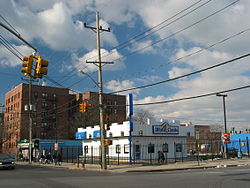Far Rockaway, Queens
| Far Rockaway | |
|---|---|
| Neighborhood of Queens | |

Far Rockaway street scene
|
|
| Country | United States |
| State | New York |
| City | New York City |
| County/Borough | Queens |
| Named for | Place name of the Native American Lenape. |
| Population (2010) | |
| • Total | 60,035 |
| Ethnicity | |
| • White | 31.0% |
| • Black | 50.1% |
| • Hispanic | 25.2% |
| • Asian | 2.0% |
| • Other | 14.3% |
| Economics | |
| • Median income | $27,820 |
| ZIP code | 11691 |
| Area code(s) | 718, 347, 917 |
Far Rockaway is a neighborhood on the Rockaway Peninsula in the New York City borough of Queens in the United States. It is the easternmost section of the Rockaways. The neighborhood starts at the Nassau County line and extends west to Beach 32nd Street. The neighborhood is part of Queens Community Board 14.
The name "Rockaway" may have meant "place of sands" in the Munsee language of the Native American Lenape. Other spellings include Requarkie, Rechouwakie, Rechaweygh, Rechquaakie and Reckowacky.
In September 1609, Henry Hudson and his crew were the first Europeans to see the Rockaways and Jamaica Bay. Hudson was attempting to go to the Northwest Passage. On September 11, Hudson sailed into the Upper New York Bay, and the following day began a journey up the modern-day Hudson River.
Rockaway was, back then, inhabited by Canarsie Indians. The name Reckowacky, which is also spelled Requarkie, Rechouwakie, Rechaweygh, or Rechquaakie, was to distinguish the Rockaway village from other Mohawk Nation villages; "Reckowacky" means "lonely place", or "place of waters bright". By 1639, the Mohegan tribe sold most of the Rockaways to the Dutch West India Company. In 1664, the English got the land from the Dutch. In 1685, the tribal chieftain, Chief Tackapoucha, and the English governor agreed to sell the Rockaways to one Captain Palmer for 31 pounds sterling.
The Rockaway Peninsula was originally part of the Town of Hempstead, then a part of Queens County. Palmer and the town of Hempstead disputed over who owned Rockaway, so the land was sold to Richard Cornell, an iron master from Flushing in 1687. Cornell and his family lived on a homestead on Central Avenue, near the Atlantic Ocean shore; upon his death, Cornell was buried in a small family cemetery, Cornell Cemetery, which is the only designated New York City landmark in the Rockaways. The Rockaway Association wanted to build a hotel on the Rockaway peninsula. The association, consisting of many wealthy members, bought most of Cornell's old homestead property. The Marine Hotel, which was built on that site, became a place where the Vanderbilt family, Henry Wadsworth Longfellow, and Washington Irving, eventually stayed. The Rockaway Association also built the Rockaway Turnpike. The Marine Hotel burned to the ground in 1864, but more hotels and private residences were built in the area.
...
Wikipedia
